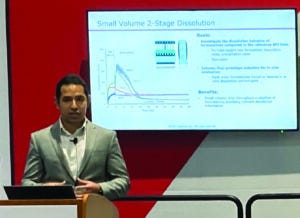- Sponsored Content
- Formulation
Rapid Screening of Bioavailability: Enhancing Technologies to Accelerate Time to ClinicRapid Screening of Bioavailability: Enhancing Technologies to Accelerate Time to Clinic
August 24, 2022
Sponsored by Catalent
 Jesus Rosales, senior scientist in oral formulation development, Catalent.
Jesus Rosales, senior scientist in oral formulation development, Catalent.
Rosales highlighted efforts to accelerate small-molecule products into clinical development. His company uses rapid formulation prototyping and both in silico and in vitro tools for technology selection. Early phase development is a tortuous path for every drug type, from identifying and validating targets and leads to optimization of drug products.
Many options are available for oral solid-dose products: basic powder forms that are reconstituted in a clinic, capsules containing only the active pharmaceutical ingredient (API), and formulated capsules and tablets with excipients that improve dissolution and/or bioavailability. No matter the presentation, preformulation and other testing is resource intensive.
From investigating solubility, permeability, and other critical characteristics to generating prototype doses and verifying those in vivo, such testing requires surprisingly large amounts of API. In vitro tests and computer modeling can help build knowledge ahead of time. In silico tools can help define a molecule’s properties, evaluate its mixability with polymers, and elucidate its crystallization tendencies to help identify potential excipients. Small amounts of prepared formulations are tested in vitro to reduce the number of prototypes needed for studying pharmacokinetics.
Such development efforts should be data driven. As with biologics, understanding an API and refining a target product profile are important to selecting the right technology options. Experimentally narrowing down prototypes before in vivo studies is crucial. Rosales touted a developability classification system that begins with the question of whether solubility enhancement will be needed. Solubility may be limited by dissolution kinetics, which can be mitigated by particle-size reduction, soft dosage forms, and high-energy polymers. Amorphous delivery forms and lipid-based formulations would be options. The latter provide protection from chemical degradation and safely accommodate very low doses and highly potent compounds with good content uniformity.
Bioavailability is a function not just of absorption, but also metabolism. Catalent evaluates bioavailability early on using pharmacokinetic modeling such as the GastroPlus software to predict a molecule’s absorption, distribution, metabolism, and excretion (ADME). Rosales highlighted liquid–liquid phase separation (LLPS) as a particularly useful in vitro technique. Understanding how solubility can be improved informs formulation development. Information regarding excipient capabilities to inhibit crystallization in solution enables rational selection of excipients to maximize solubility and maintain supersaturation both in vitro and in vivo.
Formulations also must be stable, and computer modeling can predict critical aspects such as the glass-transition temperature as a function of active load and storage humidity. “This allows us to identify potential risks with regards to physical instability without having to generate any prototypes,” Rosales said. Small-scale stability experiments include film screening of different formulations both before and after aging. Such methods limits the amount of API needed to determine optimal formulations for toxicology and other preclinical studies. Once prototype formulations are ready, Catalent uses a two-stage dissolution test to evaluate their bioperformance and ranks the options for in vivo testing based on the results. That ultimately minimizes the number of unnecessary prototype formulations needed.
Solid dosage forms need to dissolve in the gastrointestinal tract, which makes dissolution rate important. Dissolved molecules also have to cross the epithelium intact, which involves both diffusion across the mucosa and partitioning across the lipid bilayers of recipient cells. APIs must enter a vein and then move through the liver into systemic circulation. So understanding all associated limitations for a molecule is crucial to selecting excipient technologies for maximizing the fraction that ultimately is absorbed in vivo. Catalent uses solvent-based spray-dried dispersions, temperature-based hot-melt extrusions, and lipid-based drug delivery systems to maximize results.
Developing technologies early and in parallel provides information to inform later formulation decisions and minimizes the time required to arrive at an optimal formulation for preclinical and toxicology studies. Catalent can provide optimal spray-dried and HME prototypes to clients within four weeks. Preparation of prototypes for spray-dried dispersions in lipids use as little as 1 g of API each, and HME uses as little as 10 g.
One audience member asked about the difference between spray drying for oral and injectable dosage forms. Rosales pointed to the safety considerations of injectables made from shared equipment, making cleaning verification and quality systems much more strict for biologic formulations.
Fill out the form below to view the full BPI Theater presentation.
You May Also Like





